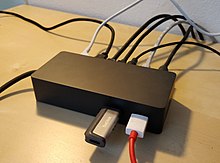Docking station
A docking station (sometimes also docking station , English to dock, "docking", "coupling") is used to connect portable devices to a fixed network. Docking stations are z. B. used in the field of digital cameras , notebooks , MP3 players or PDAs . Port replicators are also used in notebooks , although the terms are sometimes used in a misleading manner.
The docking station originally comes from the time when mobile devices were still large and heavy and certain assemblies were usually not available in miniaturized form, and so these were built into a docking station (expansion cards, optical drives, mass storage devices).
Portable devices
Docking stations usually refer to devices that connect electronic devices with data lines and the power supply. When the device is plugged into the station, the device's battery is automatically charged. Energy is supplied via the power grid as long as the device is plugged in. When connecting to computers, a connection is usually created automatically, which enables data exchange.
The docking station for pure energy supply or battery charging is intended to provide the user with a storage space for his device and increase ease of use, since cables do not have to be laid or chargers individually plugged in each time.
In Handheld Computer? The docking station is sometimes Cradle ( English for cradle) called. It is used to charge the device battery and to synchronize data with the connected computer. Synchronization software often starts automatically when the device is plugged in.
Docking stations often also offer other functions for portable multimedia players, such as remote controls or integrated loudspeakers. It is also possible to charge the battery wirelessly on special docking stations via induction. The Qi standard is often used for this.
Notebooks
Port replicator
A port replicator makes further connections available separately on a notebook via a connection on the notebook and thus enables various peripherals (mouse, printer, USB port, monitor, etc.) to be connected or disconnected with one cable . There are manufacturer-specific port replicators that can also be used to connect the power supply unit or external monitors. For this, however, a suitable proprietary connection must be available on the notebook . Some of these devices are also marketed as docking stations.
Generic port replicators
Much more common are universal port replicators, which are connected via Universal Serial Bus (USB) and are sometimes referred to as USB docking stations . This does not require any special properties of the notebook, which is why such a port replicator can usually be used in combination with all notebooks. The various interfaces are connected to the USB via converters, which in some cases results in severe performance restrictions. A port replicator via USB can be used universally:
- a high load on the USB bus results in a high CPU load when idling
- the power supply is not possible in this way.
- the graphics performance (speed and maximum resolution) of the graphics solutions of the docking station are significantly worse than the graphics card integrated in the notebook
- all USB devices share the maximum bandwidth, which leads to a loss of speed, especially with network interfaces
For the reasons mentioned, in practice at least two to three cables are usually used for stationary use (external screen, USB port replicator, power). Similar port replicators also exist for the ExpressCard slot, which then use the USB and PCIe connection of this interface and are comparable in terms of functionality.
In the future, the USB docking stations will gradually be replaced by "Thunderbolt docking stations", because the Thunderbolt interface allows multiple protocols and the like without loss of performance. a. Screen, Internet, printer, speakers, hard drives, etc. can be operated at the same time. Manufacturers such as Apple do not sell their own docking stations ( apart from the Thunderbolt display ) and leave this accessory market to third parties who need standardized open interfaces such as USB and Thunderbolt as the basis for their business.
Docking station
Notebooks are mechanically connected to the docking station via plugs with often a high density of pins . The connection can be on the bottom, back or side of the notebook. A special manufacturer-specific interface is used for this, which is why only certain series can be used with a docking station.
Most of the interfaces available on the notebook are provided on the docking station; they often also have additional interfaces such as PS / 2 , serial and parallel port , DVI , DisplayPort or Firewire , which are missing in the mobile device itself for reasons of space. With newer notebooks, two more screens can often be connected to the docking station.
There are also docking stations that allow the installation of additional hardware such as PCI , PCIe plug-in cards, hard drives , CD , DVD and floppy drives . For example, there is also a docking station from HP in which the hard drive in the docking station can be used as a NAS via the network without a notebook .
Since the mechanical structure of a docking station limits its usability to a model of the master device or at least to a model series, the structure is increasingly being reduced to a pure electrical interface (plug), built in as a so-called docking connector and / or audio combo port . So far, the individual companies have each gone their own way. The structure has not yet been standardized across companies. The interface modules of the master device are used for this. The universal range of functions as with PCMCIA or ExpressCard is mostly not given.
Since modern notebooks are getting thinner and lighter, there is often no more space for connection to a classic docking station on the bottom or back of the device with current notebook models. Instead, external docking stations that are connected via a USB-C cable or proprietary sockets are becoming increasingly popular.



